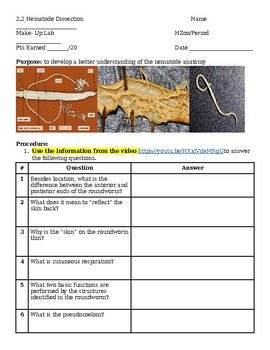
Roundworms, like the *Caenorhabditis elegans* (often just referred to as C. elegans), are not just any worms. They’re model organisms used in a variety of scientific studies, from genetics to developmental biology. Imagine having a tiny research assistant right there in your classroom. That’s what using roundworms for science demonstrations can feel like. They’re easy to handle, quick to observe, and perfect for showing students the concepts of living organisms in an engaging way.
Why Use Roundworms in Science Class?
You might be wondering why roundworms are so special. Here’s the thing: these little guys have a simple structure but are rich in biological insights. They’re transparent, which makes it easy to see their internal systems, allowing students to visualize complex processes like digestion and reproduction. Plus, they grow quickly, so students can observe generations in just a few days. This speed is perfect for classroom settings where time is often limited.
Moreover, roundworms share similarities with many higher organisms, including humans. Studying their genetic makeup can help students grasp essential concepts in genetics and evolution. When students can see this direct connection to themselves, it makes learning much more relatable and exciting. It’s like having a mini-ecosystem right at their fingertips!
Setting Up a Roundworm Demonstration
Setting up a demonstration with roundworms is straightforward. First, you need to acquire the worms. Many educational suppliers offer them, often packaged with the necessary growth medium. Make sure you have a good microscope handy. These insects are so tiny that viewing them with the naked eye isn’t practical.
Here’s a simple step-by-step guide to preparing your demonstration:
- Get the equipment: You’ll need Petri dishes, agar plates, and the roundworms.
- Prepare the environment: Cultivate the roundworms on the agar plates according to the supplier’s instructions.
- Set up for observation: Place the plates under a microscope for detailed observation.
Once everything is set up, students can start observing the roundworms’ movements and behaviors. This hands-on experience can spark questions and conversations about their life cycles, feeding habits, and habitats.
Key Learning Outcomes
Using roundworms in science classes can achieve several learning outcomes. For starters, students can understand concepts like cell division and organ systems through direct observation. This can be incredibly impactful, especially for visual learners.
Additionally, you can incorporate lessons on genetics and inheritance using roundworms. The fact that these organisms can be genetically manipulated allows students to see the effects of different traits and mutations first-hand. Imagine discussing dominant and recessive traits while observing a live specimen—it adds an entirely new layer of engagement.
This real-world connection to scientific principles helps students retain information better. It’s no longer just theory; they’re witnessing basic biological processes unfold right before their eyes.
Common Challenges and Solutions
Like any classroom experiment, using roundworms can come with its own set of challenges. One common issue is ensuring that the worms are kept alive and healthy during the demonstration. Temperature and moisture are crucial. If it’s too dry or hot, your roundworms won’t survive.
Here are a few tips to help you avoid these pitfalls:
- Monitor conditions: Keep the Petri dishes in a climate-controlled area.
- Check moisture levels: Ensure the agar remains moist but not overly saturated.
- Have a backup plan: Be ready to source more worms if your initial batch doesn’t thrive.
By being prepared and understanding how to care for these tiny creatures, you can ensure a successful demonstration that captivates students’ interest.
Roundworms vs. Other Organisms in Demonstrations
You might be asking, why roundworms instead of other organisms like fruit flies or even fish? While each organism has its pros and cons, roundworms stand out for their simplicity and ease of use. They’re less likely to escape or require complex habitats, making them ideal for classroom settings.
For instance, fruit flies grow quickly and are excellent for genetic studies, but they can be a bit more challenging to manage. Fish require more extensive setups with tanks and filtration, which might not be feasible in every classroom. Roundworms, on the other hand, are compact and require very little space—a huge plus for teachers working with limited classroom resources.
Future Learning Opportunities with Roundworms
As students become comfortable with roundworms, you can introduce further complexities. For example, you can discuss their use in biomedical research, exposing students to current scientific advancements. Understanding how these tiny creatures can contribute to cancer research or neurological studies opens up a whole new world for young minds.
Encouraging discussions around ethical considerations in research using organisms—like the impacts on ecosystems and the importance of humane treatment—can foster a sense of responsibility. This way, you’re not just teaching science; you’re teaching students to think critically about real-world issues.
Incorporating roundworms into school science demonstrations brings a hands-on approach to learning that can engage students like few other methods can. By observing and interacting with these fascinating organisms, students gain a deeper understanding of biology and the scientific method itself. The next time you’re planning a lesson, consider adding roundworms to your teaching toolkit. They might just be the perfect little creatures to help your students connect with the wonders of science in a memorable way. Plus, you never know—they might inspire a future scientist!
